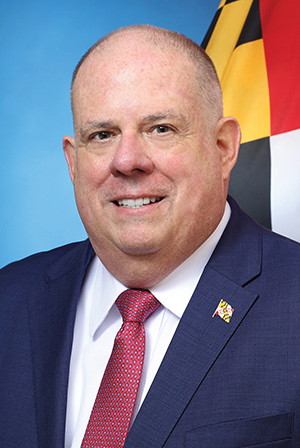Hungry for a juicy story line, some of the nation’s top scribes are suggesting that Larry Hogan is the Republican answer to Donald Trump. Larry who?
On the phone, Hogan can seem like a factory foreman with intimate knowledge of every nook and cranny of his plant. He is, in fact, the recently re-elected conservative governor of committedly liberal Maryland.
“The president’s team is watching the 62-year-old Maryland pol like a hawk,” blared Politico in January. Hogan professes innocence. “I don’t know why people keep talking about that,” he laments to Site Selection.
Either way, there’s no denying that tax-cutting Hogan, sans drama, has been a boon to Maryland’s business climate. And he’s showing that yes, we can all get along. Hogan spoke in February with Site Selection Senior Editor Gary Daughters.
Site Selection: You’ve been credited with making Maryland more business friendly. What steps have you taken to accomplish that, and what more can you do in your second term?

Gov. Hogan: It’s really the reason I ran for governor. I was a small businessman who was really frustrated with the direction our state was heading. In 2013, our overall economic performance ranked 49th out of 50 states. We had had 43 consecutive tax hikes that resulted in us losing 8,000 businesses and 100,000 jobs. I decided to run to do something about that, and that’s what my entire, singular focus has been about for four years. We’ve completely turned it around. We’ve cut taxes, tolls, fees and regulations and been unabashedly pro-business. We’ve focused on it like a laser beam, and we’ve had one of the greatest turnarounds in America.
We’ve cut taxes by $1.2 billion, cut several hundred fees and over 800 job-killing regulations. It’s now a great place to do business. We’ve dramatically changed the regulatory problem, and we’ve been chipping away at the taxes, although not as much as we would’ve liked. We’re going to continue to try to make progress on all those things in the second term. We’re proposing another half-billion dollars in tax relief with eight different pieces of legislation, and we’re going to keep focused on growing jobs.
Site Selection: In recent years the state has provided sizable retention packages to both Marriott and Northrop Grumman. Your offer to Amazon for HQ2 was the biggest in the country at $8.5 billion. Do you worry you are setting a standard that you might be expected to maintain?
Hogan: Well, look, philosophically, I would prefer to not ever have to do these kinds of incentive packages. My preference would be to lower taxes enough and to have us be such an attractive place that all businesses would want to locate here. Unfortunately, this is the way the rules are, and we were competing against states that were offering incentive packages, so we had to deal with the cards that we were dealt. And we aggressively competed. Just before I was elected, Marriott was about to leave for Virginia or D.C. We kept them here in Maryland with their world headquarters and 3,600 jobs. McCormick, an iconic Maryland company, was about to move to Pennsylvania, and we kept them here. Northrop Grumman, we kept 10,000 jobs in the state. We were very competitive on Amazon. We didn’t end up winning, but we were on the very short list along with D.C. and Virginia. It was amazing, actually, that the three of us were on the short list out of a couple of hundred places in the country that competed.
“We’ve cut taxes by $1.2 billion, cut several hundred fees and over 800 job-killing regulations.”
Site Selection: Was it blow to the state’s image to make that big offer for Amazon and then get rejected? And not just that, but losing out to your next-door neighbor Virginia?
Hogan: Obviously, we were disappointed. But beating out hundreds of places in the country isn’t exactly being rejected. It’s like, “Were you disappointed to lose the Super Bowl?” Well, yes, but we beat out all the other teams in the league. It’s a win for the region. It is going to create thousands of jobs in Maryland, and we won’t have the burden of the incentives.
Site Selection: Maryland has high land costs, high wages and high taxes, all of which help add up to high business costs. Do you see those challenges as structural, as frozen in place?
Hogan: The reason why we have high land costs is we have the best location in America. We’re close to one-third of the country’s population, we’re surrounding the nation’s capital and we’re at the heart of the East Coast. We have one of the top ports on the East Coast and in America. We’ve got the number one airport in the Washington region. We have the highest median household income and one of the most highly educated workforces in America. People are willing to pay for that. Many companies, for example, in the biotech, life sciences and cyber industries, say there’s no place else they would rather be because of all the talent we have. Some companies that are only looking for cheap land and inexpensive workforces, they would probably go somewhere else. But for many companies, there’s no place they’d rather be, and that’s why we now have more businesses open and more people working than ever before in the history of our state. We do have high taxes compared to a lot of states that don’t have many services or a very high quality of life. But we’re reducing our taxes fairly dramatically, and we’re continuing to work on that. You get a lot for your money when you come here.
“Some companies that are only looking for cheap land and inexpensive workforces, they would probably go somewhere else.”
Site Selection: Should resurrecting Baltimore be a state priority?
Hogan: It’s a huge priority, and something that we’re working on from a number of different directions. First of all, we’ve invested record amounts of money into the city of Baltimore, both in transportation and education. We’re focused on it from an economic development and commerce standpoint. We’re trying to attract more businesses there. We’ve been focused on trying to help the city address its crime problem, which is an issue that needs to be dealt with. I started a program called Project C.O.R.E., where we’ve already removed thousands of blighted properties, and we’ve encouraged the investment of $800 million in redevelopment projects in areas of Baltimore that needed help the most. Baltimore city is the economic engine of the state. It’s also an area where we have more challenges than other places. It’s a place where we’ve focused tremendous amounts of attention and we’ve invested billions of dollars.
Site Selection: You are quite the anomaly, sir. A popular Republican governor in state that’s more than two-to-one Democratic. How do you account for that, and is there anything that Washington, with all its dysfunction, can learn from Annapolis?
Hogan: Well, we’re only about 30 miles down the road from Washington, but it seems like we’re a million miles away in some respects. Maryland is only 26 percent Republican. I just became the second Republican in the entire 242-year history of our state to be re-elected. We’ve done things in a very bipartisan way. I’ve tried to reach across the aisle and come up with real, bipartisan, common-sense solutions and just focused on results and solving problems rather than trying to attack things in a partisan way. We’ve been able to find a middle ground. I think most people are really frustrated with Washington, with both sides of the aisle. They aren’t getting anything done in Washington, frankly. I think they could pay a little more attention to what’s going on right down the road here in Annapolis.
“I just became the second Republican in the entire 242-year history of our state to be re-elected. We’ve done things in a very bipartisan way.”
Site Selection: You haven’t done anything that I can discern to discourage speculation that you might challenge the President for the 2020 nomination.
Hogan: I don’t know where you heard any of that stuff. I don’t know why people keep talking about that. Like I’ve said repeatedly, I never really gave any thought to that. I’ve been saying the same kinds of things and preaching the same message since the first day I ran for governor. My message hasn’t changed. I think in today’s divisive, kind of angry politics, that message is finding a new audience since I was re-elected. I’m looking forward to just doing my job and focused on representing the people of Maryland. It’s a long way away from November of 2020. I don’t know what’s going to happen two years from now or six years from now, but right now my focus is on doing the best job I can in Maryland and representing the people that just elected me to my second term. I just got sworn in, so that’s where I’m going to stay focused for now.

